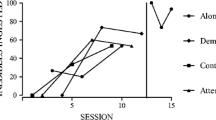Abstract
A 24-year-old autistic man in the severe range of mental retardation, a 22-year-old profoundly mentally retarded woman, and a 25-year-old profoundly mentally retarded woman were treated. They were identified for longstanding and extreme aggression and self-injury with frequent assaults on staff and other clients. Many of these episodes resulted in physical injury to others and harm to the client. Prolonged use of behavior modifying drugs including major tranquilizers of various types and dosages, Tegretol and Lithium among others, had no noticeable positive effect on these problems. The behavioral treatment employed in this study consisted of DRO, highly structured activities during all waking hours, and contingent mechanical restraint. Treatment was presented in an ABAB design for the male and a multiple baseline design for the women. Restraining was the only absent treatment component in the A phase, while all components were provided in the B phase. Treatment effects were greatly superior in the B phase. The implications of these findings for policy makers are discussed, given the growing controversy over the use of aversives (e.g., restraint), and impending litigation and laws opposing the use of such procedures.
Similar content being viewed by others
References
Aman, M. G., Singh, N. N., Singh, xxx, Stewart A. W., and Field, C. J. (1985). The Aberrant Behavior Checklist: A behavior rating scale for the assessment of treatment effects.Am. J. Ment. Def. 89: 485–491.
Axelrod, S. (1987). Functional and structural analyses of behavior: Approaches leading to reduced use of punishment procedures?Res. Devel. Disabil. 8: 165–178.
Bailey, J. (1986). Please don't do behavior modification on me. Paper presented at the meeting of the Association for Behavior Analysis, Milwaukee, Wisc.
Barrett, R. P. (1986).Severe Behavior Disorders in the Mentally Retarded: Non-drug Approaches to Treatment, Plenum Press, New York.
Carr, E. G. (1977). The motivation of self-injurious behavior: A review of some hypotheses.Psychol. Bull. 84: 800–816.
Dorsey, M. F., Iwata, B. A., Reid, D. H., and Davis, P. A. (1982). Protective equipment: Continuous and contingent application in the treatment of self-injurious behavior.J. Appl. Behav. Anal. 15: 217–230.
Egel, A. L. (1981). Reinforcer variation: Implications for motivating developmentally disabled children.J. Appl. Behav. Anal. 14: 345–350.
Favell, J. E., McGimsey, J. E., and Jones, M. L. (1978). The use of physical restraint in the treatment of self-injury and as positive reinforcement.J. Appl. Behav. Anal. 11: 225–242.
Favell, J. E., McGimsey, J. F., Jones, M. L., and Cannon, P. R. (1981). Physical restraint as positive reinforcement.Am. J. Ment. Def. 85: 425–432.
Hamilton, J., Stephens, L., and Allen, P. (1967). Controlling aggressive and destructive behavior in severely retarded institutionalized residents.Am. J. Ment. Def. 71: 852–856.
Harris, S. L. (1987). Infantile autism and childhood schizophrenia: Psychological therapies. In Matson, J. L. (ed.),Handbook of Treatment Approaches in Childhood Psychopathology, Plenum Press, New York.
Lavigna, G., and Donnellan, A. (1986).Alternatives to Punishment: Solving Behavior Problems with Non-aversive Strategies, Irvington Publications, New York.
Luiselli, J. K. (1986). Behavior analysis of pharmacological and contingency management interventions for self-injury.J. Behav. Ther. Exp. Psychiat. 17: 275–284.
Mace, F. C., Yankanich, M. A., and West, B. J. (1988). Toward a methodology of experimental analysis and treatment of aberrant classroom behaviors.Special Services in the Schools. In press.
Matson, J. L., and DiLorenzo, T. (1983).Punishment and Its Alternatives: A New Perspective for Behavior Modification, Springer, New York.
Matson, J. L., and Gorman-Smith, D. (1986). A review of treatment research for aggressive and disruptive behavior in the mentally retarded.Appl. Res. Ment. Retard. 7: 95–103.
Matson, J. L., and McCartney, J. R. (1981).Handbook of Behavior Modification with the Mentally Retarded, Plenum, New York.
Matson, J. L., and Stephen, R. M. (1977). Overcorrection of aggressive behavior in a chronic psychiatric patient.Behav. Mod. 4: 559–563.
Matson, J. L., and Taras, M. (1988). A 20 year review of punishment procedures and alternative methods to treat problem behaviors in the developmentally delayed.Res. in Develop. Disabil. In press.
Meyers, D. V. (1975). Extinction, DRO and response cost procedures for eliminating self-injurious behavior: A case study.Behav. Res. Ther. 13: 189–191.
Repp, A. C., and Deitz, D. E. D. (1978). On the selective use of punishment-suggested guidelines for administrators.Ment. Retard. 16: 250–254.
Rutter, M., and Schopler, E. (1987). Autism and pervasive developmental disorders: Concepts and diagnostic issues.J. Aut. Dev. Dis. 17: 159–186.
Spreat, S., Lipinski, D., Hill, J., and Halpin, M. E. (1986). Safety indices associated with the use of contingent restraint procedures.Appl. Res. Ment. Retard. 7: 475–482.
Author information
Authors and Affiliations
Rights and permissions
About this article
Cite this article
Matson, J.L., Keyes, J. Contingent reinforcement and contingent restraint to treat severe aggression and self-injury in mentally retarded and autistic adults. Journal of the Multihandicapped Person 1, 141–153 (1988). https://doi.org/10.1007/BF01098254
Issue Date:
DOI: https://doi.org/10.1007/BF01098254




